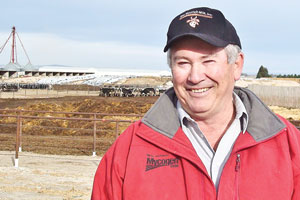“What are some of the pest or disease problems you have struggled with in your corn silage crops in past years? Will you be watching out for anything in particular this year? How have or will you treat for these problems?”
Jeff Handschke
Sugar Creek Dairy • New London, Wisconsin
 Last year with the wet saturated soils most of the summer, we ran into some eyespot problems on certain varieties of corn.
Last year with the wet saturated soils most of the summer, we ran into some eyespot problems on certain varieties of corn.
We were able to keep them in check with an aerial application of a fungicide, which worked quite nicely.
Knowing that, this year we are planning to apply a fungicide at the 5- to 7-leaf stage, and we may add foliar fertilizer treatments, depending
on tissue samples.
Corn borer and corn rootworm numbers have been lower over the past two years so we are planning on using some conventional seed and some corn borer-resistant seed to spread costs and risk.
Rodney Elliott
Drumgoon Dairy • Lake Norden, South Dakota
 I work very closely with my local agronomist and our Croplan Genetics representative to monitor field conditions. They are my eyes and ears, as I am very busy with the dairy side of our business.
I work very closely with my local agronomist and our Croplan Genetics representative to monitor field conditions. They are my eyes and ears, as I am very busy with the dairy side of our business.
We work together to make sure we have varieties on my farm with resistance to as many diseases and other insect pressures as we can.
Unless we get a piece of land that is really low and wet, we generally don’t have disease issues that cause a real economic problem.
In our hay fields, alfalfa weevils generally show up as we are getting ready to take the first cutting. If the levels are too bad, we will spray with insecticide to allow the regrowth to outgrow the feeding of the weevils.
The other alfalfa pest we keep a close eye on is the potato leaf hopper. Keeping them out of the newly seeded fields is our first and most important task.
Scott Reiland
Reiland Farms • LeRoy, Minnesota
 We plant a lot of corn-on-corn, so it can be a pretty harsh environment. To help us address any pest problems that might come up we’ll plant BMR with Herculex® XTRA Insect Protection this year.
We plant a lot of corn-on-corn, so it can be a pretty harsh environment. To help us address any pest problems that might come up we’ll plant BMR with Herculex® XTRA Insect Protection this year.
We also will be watching for leaf diseases like gray leaf spot, as we’ve experienced some problems over the years.
If the conditions are right and this area is showing potential for leaf diseases, we’ll scout the fields around the middle of July or before the R1 or silking stage.
If there are problems, it’s important to detect them early on. In addition to scouting as needed, we rely on news and information that comes from our local university Extension offices.
Keith Dawydko
Anchor Farms, Inc. • Clarence, New York
 A big thing that we look out for here is black cutworm. We are zone-tilled, and they like a lot of residue to live in, so our crop consultant is out scouting for those pretty heavily.
A big thing that we look out for here is black cutworm. We are zone-tilled, and they like a lot of residue to live in, so our crop consultant is out scouting for those pretty heavily.
In the damp, cool spring we get a lot of times, we’re always looking for seed corn maggot. Mid-season we’re looking for armyworm.
And around tassel time we’re scouting for rootworms (more for the next season). The last couple of years, we’re starting to see western bean cutworm, so we’re keeping an eye out for those in our area, too.
We’re not treating anything unless it’s there. If we do have a problem from the year before, we’ll often rotate to a different crop. We are also using some of the stacked traits that help prevent some of the seedling diseases to help protect ourselves even more.
Ray Robinson
Moo Mountain Milk and East Ridge Milk • Burley, ID
 We’re very fortunate that we haven’t had any major pest or disease problems in the last several years – at least nothing we’ve ever treated for.
We’re very fortunate that we haven’t had any major pest or disease problems in the last several years – at least nothing we’ve ever treated for.
With more than 5,000 acres of forage, we have a lot of rotation and are able to stay on fairly new ground. However, if we do go with a corn-on-corn rotation, we use the BMR with Herculex® XTRA Insect Protection to help with pest control, specifically rootworm.
And my partners are in the fields regularly checking moisture levels, so I rely on them to identify any signs of pests or potential disease problems. Scouting fields to detect pests or diseases early on is a key to staying ahead of the problems and getting on top of them before they get out of control. Seed selection often plays a big role, as well.
E-mail to tell us what you are seeing this season.











